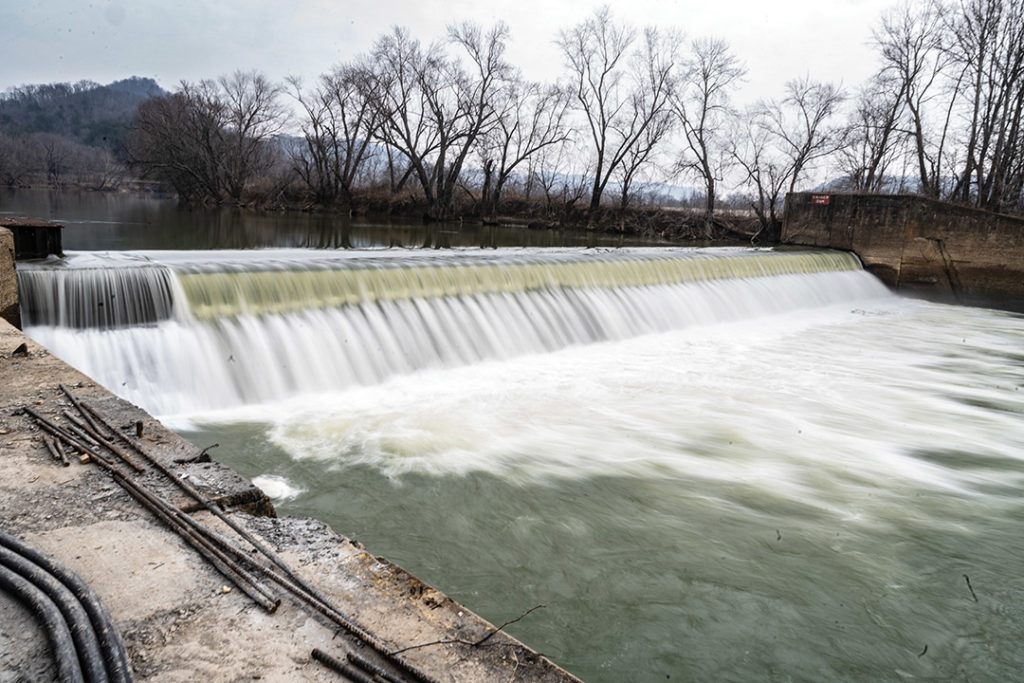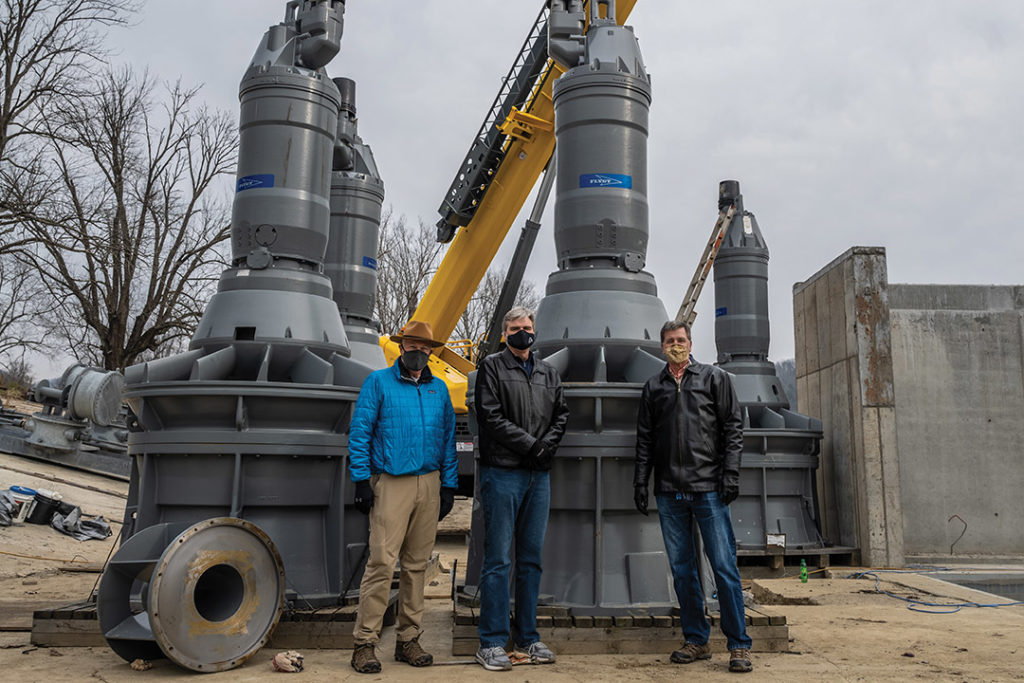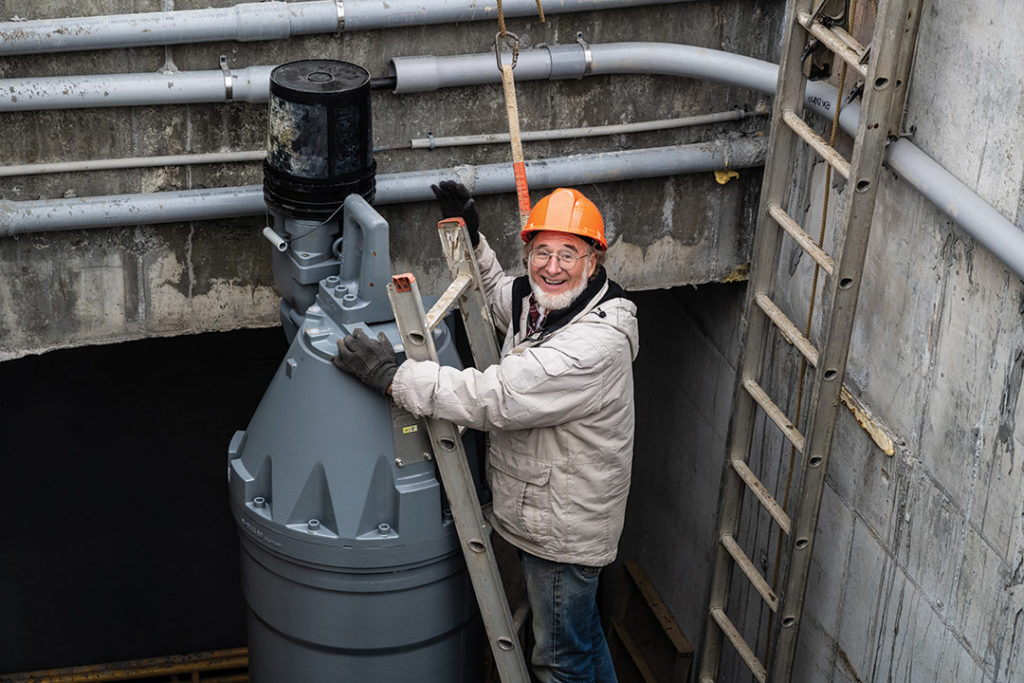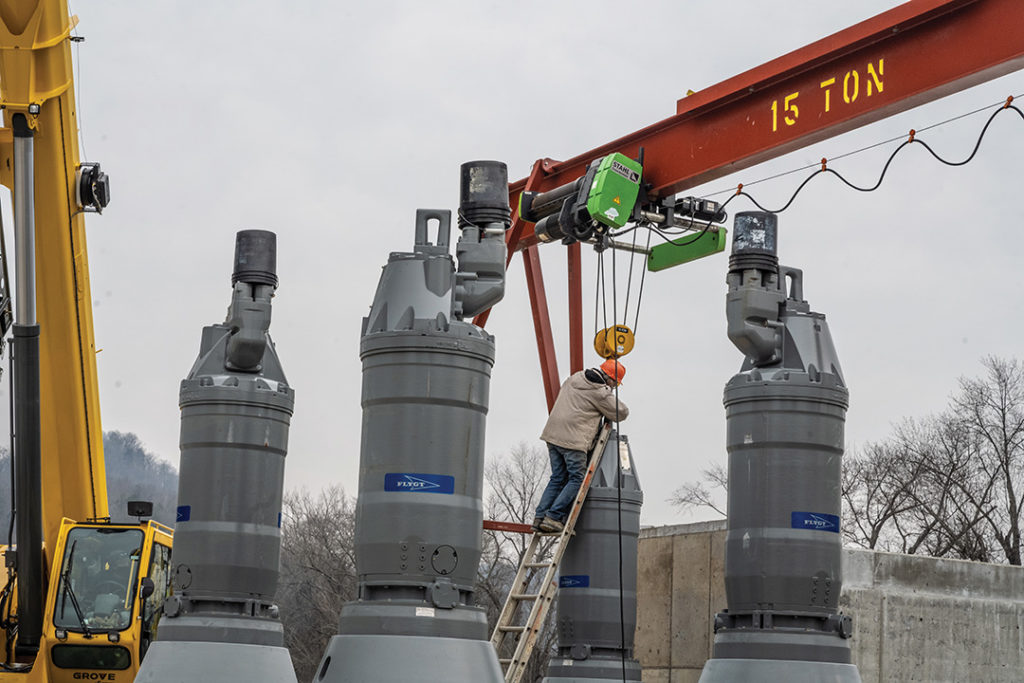In Estill County, along a stretch of the Kentucky River, five turbine generators are converting a million gallons of water per minute into clean electricity. The 13-foot tall, 23,000-pound turbine generators represent just some of the marvelous technology being used at the Matilda Hamilton Fee Hydroelectric Station, the first hydro plant to be completed by an American college or university. It is also the first small hydroelectric plant built in Kentucky in 94 years.
Considered “a demonstration project,” the station is also the first new hydro plant in the nation to use variable speed drives on its generators, a technology borrowed from the wind industry. With so many firsts, it’s apropos that this hydroelectric generating station be named for Berea College’s first “First Lady,” partner of founder John G. Fee and heroine of the Berea story.

In 2011, a novel idea to retrofit an old lock and dam facility into a hydroelectric power plant was being discussed in a campus coffee shop. Dr. Jan Pearce, professor of computer and information science at Berea, was bending the ear of the College’s general counsel, Judge Wilson II ’78, about her husband, Bob Fairchild, and his work with Appalachian Hydro Associates (AHA). The engineers at AHA were looking for a partner on a new project at Lock and Dam 12, near Ravenna, Ky. The proposed hydro project would require a lot of cash upfront and the patience to accept a return-on-investment realized over a long period of time. Berea College, with its shared interest in addressing global climate change and investing in Appalachia, could be the perfect partner, so long as the project could be made financially viable.
The grand design
Early last century, a series of 14 locks and dams were constructed along the 263 miles of the Kentucky River to move cargo. The railroads and, later, state and federal highways, pushed this navigational system into obsolescence. By the 1990s the upper locks were closed to river traffic and welded shut.

Photo by Crystal Wylie ’05
The engineers at AHA had proven themselves through their purchase and restoration of the century-old Mother Ann Lee Hydroelectric Station at Lock 7 from Kentucky Utilities, which had plans to decommission it. David Brown Kinloch, AHA president, led the effort to modernize the plant with microprocessors, stainless steel, high-density plastics and automation that allowed it to be remotely operated, and thus kept the plant producing clean energy.
AHA was now ready to apply what they had learned at Lock 7 to a new project. They chose Lock 12 because of its proximity to power lines, roads and other resources. Finding a partner, though, meant they were going to have to make a solid financial argument, beginning with finding a way to build a less expensive hydroelectric power plant.
Much of the cost of adding a new hydro plant to an existing non-powered dam involves where and how to build the turbine generator powerhouse. Using the abandoned navigational lock would lower this cost by a third. The Kentucky River Authority, which owns the lock and dam, was supportive but required that no modifications be made to the dam itself. This meant that the powerhouse had to be designed to fit within the existing lock structure.
AHA enlisted the hydropower engineers at Kleinschmidt Group to design a powerhouse that could be “shoe-horned” into the lock. They would be able to do that with fully submersible turbine generators developed by Xylem, a leading water technology company based in Sweden. These turbines had significant advantages over conventional turbines. Because they were submersible, they were unaffected by flooding, and they were designed to last 50 years, twice as long as those used for wind or solar plants. Each turbine generator is capable of producing 528 kilowatts of power, for a total plant output of 2.64 megawatts.
In addition, variable speed drives not only increased turbine efficiency, they allowed the plant to sync easily to a power grid with existing distribution lines, a significant cost saving.
“The big thing we’re doing here is we’re using variable frequency drives,” Fairchild said, “which basically allows us to let the turbines run at whatever speed they want to run, rather than being fixed by the grid to run at a specific speed.”
A green investment
Some environmentally friendly projects require a lot of green. In the case of the Matilda Hamilton Fee Hydroelectric Station, AHA was going to need about $11 million to make it work. But at that price point, the rate of return might be considered underwhelming. Berea saw the project as a chance to make good on the College’s commitment to sustainability while providing an educational opportunity for students interested in green technology. Raising the rate of return high enough to justify the investment was going to take some creativity.

Photo by Crystal Wylie ’05
One of the creative forces behind what may be the most complex investment project in the College’s history was Wilson, who is quick to point out that without the active support of President Lyle Roelofs; the College’s Board of Trustees; and key advisors, agencies and participants, the project could not have happened.
Roelofs notes that to reduce the cost of the project to the College required making use of various tax-credit opportunities. “In order to take advantage of these great opportunities,” he said, “you have to have somebody who really knows the way around this complex terrain. We’re very thankful that Judge has been our arranger of such opportunities. He deserves a tremendous amount of credit for making this project work financially.”
The financial solutions lay in the utilization of federal and state New Markets Tax Credits as well as investment tax credits. Berea College, a nonprofit, could not take advantage of the investment tax credits, but investors in the business sector could, and one did. After providing construction financing from its own funds, Berea partnered with AHA, Community Ventures Corporation, Midwest Renewable Capital and Community Impact Fund, U.S. Bank, Chase Bank and Hardscuffle, Inc. Some of these vehicles take some time to play out, but the end result is that Berea’s net investment cost will be significantly reduced.
“When you look at the cost reduction and expected rate of return on this investment,” Roelofs said, “after we take advantage of all the different opportunities for projects like this, we will actually exceed the average endowment rate of return.”
“The project is expected to provide a stable rate of return over its useful life, which could well exceed 50 years,” Wilson added.
Goodbye, carbon footprint
One million gallons of water weighs 8,340,000 pounds, and until this summer when the Matilda Hamilton Fee Hydroelectric Station came online, the sheer downward force of all that weight was going to waste as it flowed over Dam 12. Now, the electricity produced will offset about half of what Berea College uses each year, pushing the school another big step closer to its goal of eliminating its carbon footprint.
“It’s a demonstration of the College’s commitment to sustainability,” Roelofs said. “The dam was here. The lock was here. The water was flowing. We could turn that into electricity, and the power grid uses less coal and natural gas.”
The electricity produced will not be used by the College directly. Instead, the power is being sold to Jackson Energy Cooperative, and the station will power about 1,200 homes in Estill County.
“This is a response to climate change,” Kinloch said. “This is clean, renewable energy. We will eliminate about 11,000 tons of carbon dioxide in the air every year.”
Berea College’s share of revenues generated by the plant will be funneled into the College’s operating budget to help cover the costs of providing every student with a Tuition Promise Scholarship, which covers the cost of tuition.
“We’re glad that the money, the investment, is being used to teach students that otherwise couldn’t go to college,” Fairchild said. “We believe in the mission of Berea College as well.”
In addition to being a solid investment in clean energy, the hydropower plant presents an opportunity to teach students interested in creating a sustainable future.
“We don’t want students to think of sustainability as just an abstract concept that has something to do with recycling or buying an electric vehicle,” Roelofs said. “We want the students to see that to really pursue sustainability, you do big things like this. Perhaps our success in this endeavor will inspire other entities to do similar things.”
In furtherance of the College’s commitment to Appalachia, building hydropower plants like this one employs local labor and businesses. Wright Concrete and Construction, based in Pikeville, Ky., poured more than 2,700 cubic yards of concrete for this project. The project also has a recreation component that includes portages for canoes and kayaks and a picnic pavilion. And a park will be developed at the request of Ravenna residents.
Berea and AHA are already looking forward to their next collaborative effort, a hydroelectric plant at Lock 14 on the Kentucky River near Heidelberg in Lee County. The combined effect of these plants, together with the College forest, means “Berea’s carbon footprint will be negative,” Roelofs said.
Just as the legacy of John and Matilda Hamilton Fee endures with each new generation of Berea students, the College’s commitment to sustainability continues with the Lock 12 plant now named for Mrs. Fee.



Thanks for doing this project. How is the next project going? How are they raising money for this, and are they selling bonds for this project? Thanks Dave
Dave,
In all honesty, I do not have any information on how the next Lock 14 project is going. I know there have been conversations, but I do not know beyond that where they stand. Thank you for reading, and I’m sure as the project gets underway, we’ll include an update in a future issue!